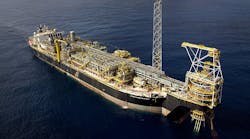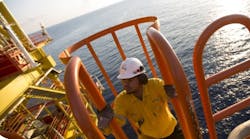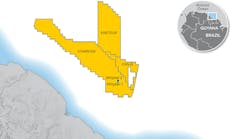Bruce Crager
Endeavor Management
Any company that undertakes an offshore field development must proceed through a process to determine the best alternatives available to develop their field. Companies who do not follow a rigorous concept identification/selection process fall into traps that leave considerable value on the table. It is important to consider all viable concepts that explore potential approaches to increasing value and mitigating risk.
Many companies evaluate field development alternatives by using a stage gate process that includes formal concept identification and concept selection phases. However, it is also common for companies to favor field development concepts based on prior experience, using past concepts, without fully evaluating other options. Other operators, generally those with less experience or smaller budgets, may perform a minimum amount of concept selection, omitting attractive concepts. To ensure a successful outcome, concept identification and selection are process steps that cannot be overlooked. It does not have to be a long and expensive effort, but it should ensure that all viable options are considered, including those that might be considered innovative.
One common method for comparing different concepts is to use decision analysis (DA). The DA process starts with framing the problem to ensure all stakeholders agree on the structure of the problem; e.g., what is being considered and what will not be considered, objectives, decision criteria, givens, and so on. DA uses a numerical model in which key alternatives can be evaluated and compared. Inputs would normally include production profiles for each well, costs and schedules for drilling and facilities, operating cost over the life of the field, and key economic criteria such as discount rate, price of oil, and production-sharing terms. The outputs of the DA model might include net present value (NPV), return on investment (ROI) and cash flow.
Here, we take the example of a brownfield project where infield drilling and knowledge of reservoir performance over time indicates that there are more reserves and recovery to be had. The current infrastructure does not have the capacity to produce the extra barrels. The goal of the exercise is to identify what alternatives exist for developing this currently untapped potential and compare these to select the one or two best concepts. In this type of project, there are five key drivers that must be considered:
- Reservoir performance
- Capital cost
- Operating cost
- Economic recovery
- Life of field.
Concept identification
To ensure that all alternative approaches are identified, ideas should be solicited both internally and externally. This process gives internal operator groups the opportunity to include ideas with input from additional geographical regions, as well as the opportunity to learn from experience gained by their peers with other technologies. External sources may offer solutions less known to the operator.
The goal of the identification phase should be focused on finding as many viable concepts as possible to make sure nothing is overlooked. This process is much like brainstorming in that no alternatives should be removed until everything has been listed and categorized. Concept identification/selection is often focused on facilities and should include appropriate facility disciplines such as process, structural, floating production, and subsea systems, as well as operations.
To begin the concept identification effort, it is important to develop key design criteria. Accurate subsurface characterization is essential (ranges and best estimates) including well counts, production flow rates, water injection and artificial lift requirements, gas injection/utilization, and crude properties. Existing infrastructure information is also critical, such as storage/pipeline capacities and production facility capacities and constraints. In addition, all data that is "known" should be identified at the outset.
Known data may include water depth, GPS location, other active fields in the surrounding area, and any known partner/government requirements and preferences.
Best practices
Below are a number of points to consider when listing best practices. Start by listing every major alternative and any viable sub- options. For example, a spar or tension leg platform is not practical for a field in 300 ft of water, but other types of floating systems or fixed platforms could be used.
List prototype and "first of the kind" concepts in the initial effort if these are a good fit for this location. However, these should be discussed with the operator and potentially the field partners to determine if they will consider a unit that has not been proven previously.
Document all options that are considered, including those that are deleted early in the process. Use of these options may be questioned later and it is important to document why they were removed. Avoid becoming bogged down in costs. Make high-level estimates, if necessary, to resolve multiple options that are similar in other respects but do not try to develop specific detailed costs for all options.
Involve the operator, operating partners, and key stakeholders as often as is reasonably practical. Other possible stakeholders may include appropriate government entities, existing contractors (such as an existing FPSO lease provider), and adjacent operators whose facilities might be utilized. The purpose of this communication is to ensure that all concerns and biases are addressed as soon as possible. The operator will decide how much shared information is appropriate, but generally, the more feedback at this point the better. Key feedback can include schedule, quality, and cost expectations for the project.
It is critical to obtain partner agreement on basic assumptions – a process often referred to as "framing." A simple example of framing would be deciding which future reservoirs are included and which are not. Other items needing agreement may include number and locations of wells and downhole completion configuration (electrical submersible pumps, gas lift, gravel pack, etc.). Specific criteria such as production rates and number of wells are required in order to evaluate the various field development concepts.
Concept selection
The selection process begins with a series of efforts to reduce the number of concepts. Generally, the amount of effort per alternative concept increases as the number of alternatives is reduced. It is important to obtain regular stakeholder review of the inputs to the Decision Analysis model during the process.
This step will avoid many of the arguments that may occur when the results are presented, because inputs and the method of modeling are understood and agreed upon up front.
The DA model provides numerical outputs such as net present value, return on capital, total recoverable reserves, and cash flow over the life of the project. These outputs must be evaluated with technical issues captured as pros and cons of various alternatives. These qualitative and quantitative results can be used to continue to compare and reduce the number of concepts. Initial analyses can be run deterministically to get first order insights on what drives the best results and then probabilistically to better understand the major risks and opportunities from the uncertainties.
Often, several alternative concepts have benefits that can be combined into a "hybrid." This hybrid can then be evaluated using the DA model to ensure it improves on other alternatives. Major assumptions made in the initial phase of the project can be checked using the DA model to determine if they make a significant difference when changed.
The end result of concept selection is likely to be one or two alternative concepts with sub-options that can be evaluated prior to the front-end engineering design (FEED) phase. This evaluation, commonly referred to as pre-FEED, normally takes three to six months. At the end of pre-FEED, there should be one field development concept with a specific design basis for FEED where detailed engineering, costing, and scheduling can be performed.
Case study
Let's explore a recent project for West Africa in about 200-ft water depth. This project underwent an identification phase that generated a large number of concepts to expand the existing field. The field already had an FPSO with wellhead platforms and subsea tiebacks. More wells and increased production throughput appeared to be profitable based on recent drilling and reservoir modeling.
Major concepts identified initially included more platforms (both wellhead and full production), floating facilities (including semisubmersibles with FSO, expansion of the existing FPSO, and a replacement FPSO), a jackup production facility, and more subsea tiebacks (including direct tieback, manifolds, daisy chain, and subsea processing). These major concepts were then compared on a relative basis. This step resulted in a large number of initial options, which were then filtered to about 20 viable options using comparison criteria.
These criteria, developed by the project team and approved by the operator, included: minimize risk; continuity of revenue stream; minimize estimated capital cost; minimize estimated operational cost; minimize schedule; maximize flexibility for future expansion; and maximize reuse of existing facilities.
This subjective grading was carried out by a group of knowledgeable engineers from various disciplines before formal costs and schedules were developed. The purpose was to reduce the number of options before performing more complete DA, so there were no formal economic results to compare, such as net present value.
In this project, it was initially felt that expansion or replacement of the existing FPSO was the logical solution. However, the option of a semisubmersible production system with an adjacent FSO, in place of an FPSO, was retained for the concept selection phase. While two floating units were expected to have a higher operating cost versus one FPSO, the semi could also have workover capability. This could be quite cost effective if subsea wells were placed below it that needed regular workover.
While it is generally not necessary to identify specific existing production units during the identification phase, it can be advantageous to check the current market for existing or speculative floating or jackup production facilities that might be compatible with the specific field being evaluated. This process ensures that a concept based on an available existing vessel is not excluded prematurely. It is important to note that an existing production unit can potentially be less expensive and can also bring on new production more quickly.
After the 20 options were identified for a given set of production profiles, pros and cons were developed for each major alternative. The 20 options were then reduced to six. At this point, a more rigorous cost and schedule effort was developed for each one, so that they could be more closely compared using the DA model.
In this example expansion project, the FPSO had process throughput limitations but had enough storage capacity for increased production. A viable hybrid was to add a new production platform, instead of a wellhead platform, with all existing wells routed to this new platform. Processed crude could then flow through a single pipeline from the new production platform to the FPSO which would now act as an FSO.
The new production platform with FSO compared favorably to other options. The hybrid (production platform with FSO), when looked at probabilistically, increased NPV by several hundred million dollars, because it provided additional processing capacity capable of handling the upside of the production profile uncertainty. Deterministically, the NPVs were virtually identical. The costs of the two alternatives were identical. The qualitative advantage of the hybrid was that it naturally mitigated the risk of failure (need for trip to dry dock) with the current aging FPSO.
Offshore Articles Archives
View Oil and Gas Articles on PennEnergy.com







